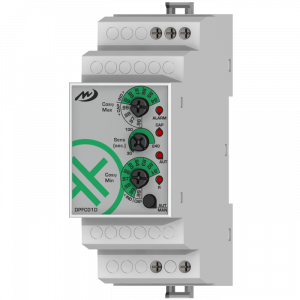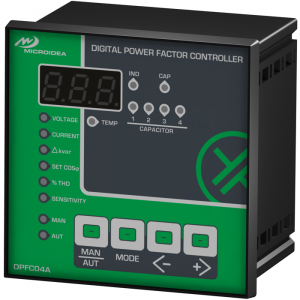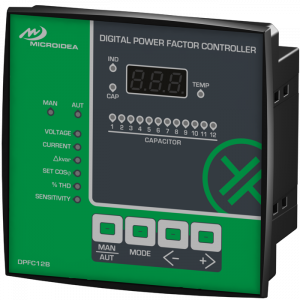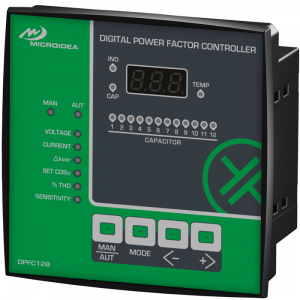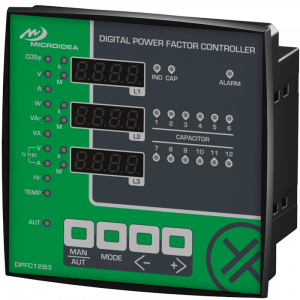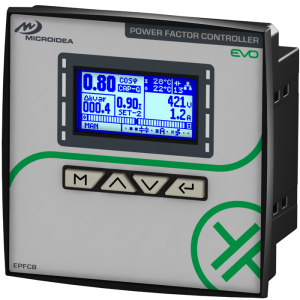Power Factor Regulators
The tradition of industrial power factor controller
The DPFC line of automatic power factor controller allowed Microidea to penetrate the world of industrial power factor control and green energy as far back as 2009. For Microidea, the concept of consumed energy quality is the basis of all its products.
The ability to use all the energy you pay for is by no means a matter of course, but it is a goal to be pursued attentively and consistently. Microidea developed an entire range of power factor controller and correction devices.
To comply with any high demanding task, our critical components are designed for high accuracy.
We develop our products in order to achieve a precise power and current limiting, maintaining the power factor even in constant power mode usage.
What is a power factor controller for?
Under an electrical engineering point of view, we define the power factor of an electrical system as the ratio between the real power that is absorbed by the load and the power inside the electical system. A Power factor controller is used to maintain this value in a segment identified by the National Authority.
A power factor interacts with the real and reactive power of a power supply. Power factor controller is used to reduce the phase shift between the voltage and induced current in a reactive load. In fact, these devices are able to read the phase shift between the voltage and current absorbed by the load in real time, and use a specially designed algorithm to connect and disconnect banks of capacitors so that they consume part of the absorbed energy, transforming it into usable energy.
This reduces the phase shift created naturally in all applications that use electric motors, industrial processes that use welding machines, or in the world of HVAC (heating and air conditioning). Power factor controllers are very important because they keep the power factor of the whole system power within the limits established by the National Electrical Energy Agency, thereby avoiding potentially severe economic penalties for companies which do no comply energy star commitments and rely on poor power factor.
Not only that, power factor controller and regulators also have a positive effect on electricity consumption. With power factor controller we can keep the power factor close to the optimal value of 1, preventing waste and overloading.
A large use of a power factor controller in electrical systems allows to maintain the amount of real power used by the system. The total power and the power quality are under control as far as the real power watts disposable for the applications.
Active power factor correction plays a key role in the control and monitoring of the cos φ (power factor) and the system power quality in ac circuit. Installing a power factor controller allows to increase the power factor of a load, generating more energy inside the system.
A power factor regulator has wide range of applications from industrial to commercial networks: buildings, chemical plants , pulp and paper, cement, plastics industry, printing, food industries and mining steel industry...
PFC: power factor correction (Also known as power factor controller)
The PFC is normally included in many computers and power supply boxes. The PFC is important to reduce the total amount of reactive power generated by a computer or in general by an electronic device.
The reactive power manager at right angles of the true power energizing the magnetic field of power core.In electronic devices the reactive power hasn’t any real values, but electric suppliers charge for the reactive power and the real one. A bad management of this values causes unnecessary charges.
The new EU electric and green energy laws are required for all power supplies shipped to Europe.
Power factor controllers: some numbers
In power factor correction, representing as “k” the power factor you can obtain the ratio of true power indicated by kwatts dividing it by the reactive power (also known as kvar).
Power factor correction values are indicated by a range between 0 to 1. To be efficient any electronic device must be above 0.8.
For example, a standard power supply has, in average, a power factor of 0.70 meanwhile the same power supply with a power factor controller can obtain an impressive power factor of 0.95/0.99.
The PFC control is really important in may industries: form massive reduction of fluorescent and high bay lighting to induction welders. By arc furnaces to many equipments used in electrical engines.
Why you should install a power factor controller
When the power factor goes below 1, it needs a utility to create the real power. This will lead to an increase in the costs for energy generation and tramission. Installing a power factor controller will then results in a decrease in economic costs for energy.
Contact us now to know more about Microidea power factor controller, its features and price.


